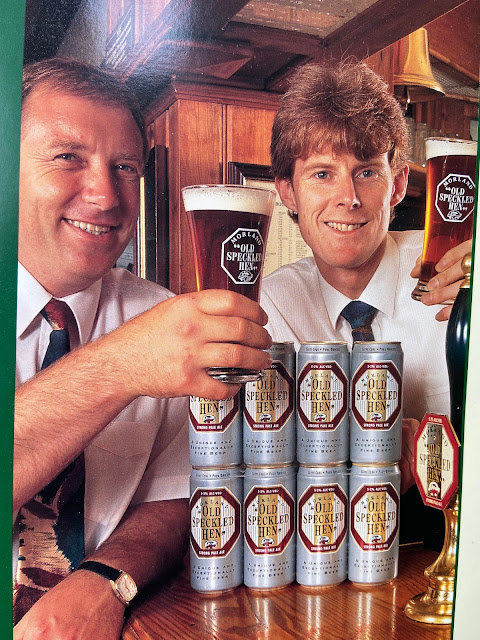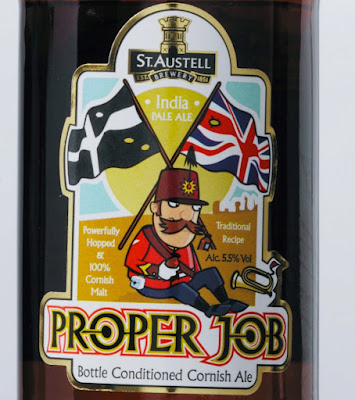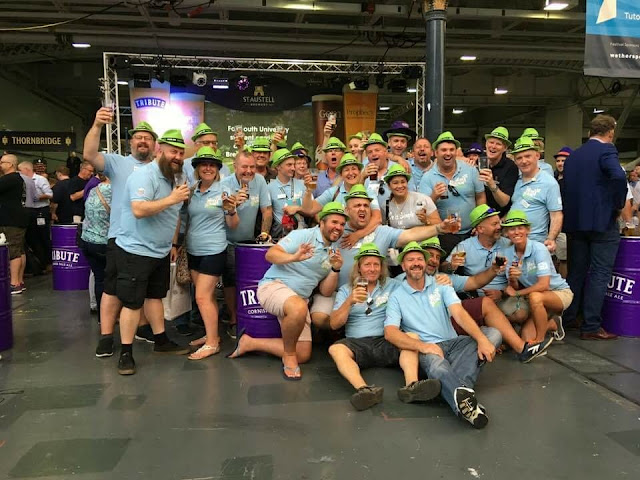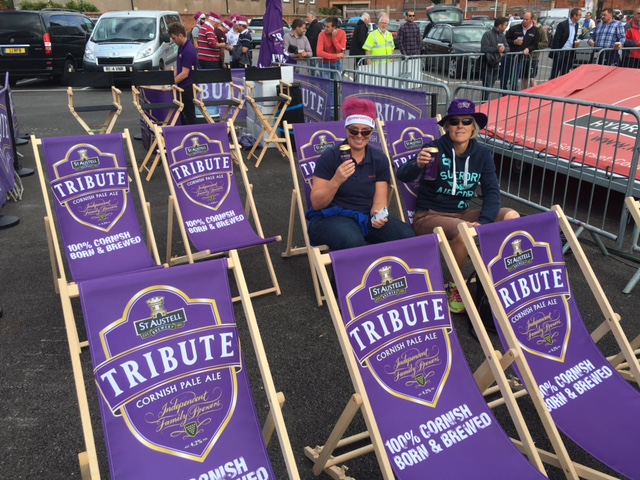Very few beer brands manage to survive for a 50 year history so its remarkable to note that St Austell Brewery HSD is not that far from reaching this momentous anniversary. It was first brewed on 4th June 1975, an idea from the then Head Brewer, Alan Izat. His rationale was that most of St Austell's other brands at this time were at the lower end of the abv scale so decided to brew a beer at 1050og, hence the 5% abv. HSD would also appear in different uniforms over the years, examples including St Austell Jubilee Ale and Royal Wedding Ale, both of which were bottled conditioned HSD.
HSD, or to give it its full name, Hicks Special Draught, is a beer that has become legendary. Talk to a tourist who visited Cornwall in the 1980s/90's and it seems many will have a fond but respectful memory of drinking HSD! Named after Water Hicks, St Austell's founder, locals have even given the HSD initials new names with High Speed Death, High Speed Diesel or Hang Straight Down to name but three. A full bodied strong ale, HSD packs plenty of caramel toffee and dried fruit flavours. As I sit here writing this post on a cold winters day in December, its hard to think of a more suitable day to enjoy a pint of HSD.
When I first joined St Austell Brewery in early 2002 the original plan was that HSD was the beer we hoped to turn into the next Old Speckled Hen. The abv was similar, the flavour of the beer was similar and we had a sizeable marketing budget to invest in its launch. However, the market had changed and HSD was not the right beer - consumers were now more interested in golden hoppy beers and the citrus flavours they gave. HSD is brewed with English hops, Progress and Golding, both great hop varieties but they gave bitterness and balance to brews rather than big hints of tropical citrus notes. Fortunately St Austell Head Brewer Roger Ryman, had another beer up his sleeve called Tribute that did play the new tunes required and the rest as they say is history. However HSD did not fade away, far from it in fact.
 |
| Head Brewer Roger Ryman in 2012, meeting of St Austell's Taste Panel |
The one thing that HSD had going for it was its reputation for being a fine beer locally. It was untainted by the St Awful or Thinners nicknames (a play on Tinners which was St Austell's house bitter at the time) - if we are honest, St Austell had become known for questionable beer quality and unexciting brands towards the latter half of the 20th century, but HSD rose above this and continued to hold its place at the top table for local beer lovers. Of course under Roger Rymans leadership St Austell's brewing reputation would quickly recover and prosper.
HSD has had a few scares over the years to its longevity. I recall we were once challenged by Gales Brewery of Horndean who implied that St Austell were passing off HSD as their own HSB (Horndean Special Bitter). Of course that was quite ridiculous, not least because the two brands paths barely crossed each other on a geographical basis. Several Solicitors letters were swapped over that particular accusation which thankfully eventually came to nothing, bar some expensive solicitors bills!
Another threat came internally as St Austell once pondered replacing HSD on draught with Admirals Ale. We were looking at the future of Admirals Ale and decided there was not room in our portfolio for two strong beers at 5.0% abv. We deemed Admirals as the more marketable as it had earned many brewing awards and also had some good listings in supermarkets. The plan was to carry on brewing HSD in bottle and perhaps the occasional appearance as a guest beer on draught. However we reckoned without the local CAMRA branch and other beer enthusiasts who were dead against this idea. We quickly came to our senses and to avoid a PR own goal changed our plans. Sadly Admirals Ale was eventually culled as we could find no place for it in our draught ale portfolio and the supermarket bottle listings eventually fell away.
From a marketing perspective the HSD pump clip and label designs always seemed to play second fiddle to St Austell's main brands i.e. Tribute and Proper Job were the focus. HSD always received its new uniform at the various rebranding exercises over the years but never quite got the same attention as other brands. However the very latest rebranding which took place a couple of yeas before I left, I'm pleased to say I was very happy with the new look HSD, giving improved shelf standout and solid pump clip design that reinforces the strong ale character.
 |
| Last St Austell rebranding showing latest HSD pump clip design |
Roger Ryman also increased the abv to 6% in bottles for while. He rightly argued that its description of Strong Ale was no longer relevant as 5% was now the norm for beer drinkers. Bottled HSD at 6% was a really good beer and I certainly drank my share, the increased abv complemented and enhanced the flavours. Sadly the increase in abv also came with an increase in paying beer duty which made HSD somewhat borderline in terms of profitability as supermarkets would not accept the price rise being passed on. HSD was therefore reduced back down to 5% in bottles - there are few decisions I'd disagree with from my St Austell days but this was one. Roger was right, the higher abv beer was a better beer and we had such few supermarket listings that it was not really relevant. Disappointingly many of those listings would disappear anyway.
 |
| Bottle of HSD at 6.0% abv - a very fine beer |
So as HSD approaches its 50th anniversary in mid 2025, I am proud to have been part of its custodianship for a few years during my time at St Austell. HSD was never my most favourite beer, but it was always there and its very presence gave the beer portfolio a solid appearance imparting tradition and heritage that the other brands could not offer. Today, HSD can still be found in many of St Austell Brewery's own pubs and it also regularly pops up as a guest beer in various freehouses in the South West. So, if you come across it, do enjoy a pint as you'll not be disappointed, especially if its a cold day!
 |
| St Austell draught range at a beer festival shown circa 2013, |











.jpg)

.jpg)

















